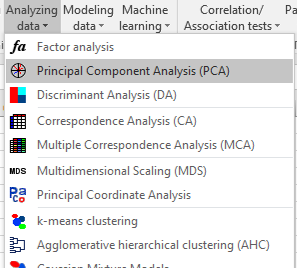

#Xlstat calculate confidence interval series
Several white noise tests, based on the ACF, are available to test whether a time series can be assumed to be a white noise or not. Obtaining a white noise means that all deterministic and autocorrelations components have been removed.

One important step in time series analysis is the transformation of time which goal is to obtain a white noise. Normality and white noise tests at different time lags The ACVF, the ACF, the PACF and CCF are computed by this tool. The cross-correlations function (CCF) allows to relate two time series, and to determine if they co-vary and to which extend. The theory shows that the PACF function of an AR(p) – an autoregressive process of order p - is zero for lags greater than p. The visualization of the ACF or of the partial autocorrelation function (PACF) helps to identify the suitable models to explain the past observations and to do predictions. The sample autocovariance function (ACVF) and the autocorrelation function (ACF) give an idea of the degree of dependence between the values of a time series. Autocovariances, autocorrelations, and partial autocorrelations If the answer is yes, then the next question is how. One of the key issues in time series analysis is to determine whether the value we observe at time t depends on what has been observed in the past or not. Using fast and powerful methods, XLSTAT automatically computes the Fourier cosine and sine transforms of X t, for each Fourier frequency, and then the various functions that derive from these transforms. XLSTAT optionally displays two test statistics and the corresponding p-values for white noise: Fisher's Kappa and Bartlett's Kolmogorov-Smirnov statistic. XLSTAT suggests the use of the following kernels: The weights, are either fixed by the user, or determined by the choice of a kernel. The spectral density estimate (or discrete spectral average estimator) of the time series X t uses weights. From the periodogram, using a smoothing function, we can obtain a spectral density estimate which is a better estimator of the spectrum. However, we usually have only access to a limited number of equally spaced data, and therefore, we need to obtain first the discrete Fourier coordinates (cosine and sine transforms), and then the periodogram. The spectral density corresponds to the transform of a continuous time series. From there we can obtain decomposition the autocovariance and autocorrelation functions into sinusoids. The spectral representation of a time series X t, (t=1,…,n), decomposes X t into a sum of sinusoidal components with uncorrelated random coefficients. Spectral analysis is a very general method used in a variety of domains. By studying the spectral density, seasonal components and/or noise can be identified.

It is then possible to build representations such as the periodogram or the spectral density, and to test if the series is stationary. The magnitude and phase can be extracted from the coordinates. Spectral analysis allows transforming a time series into its coordinates in the space of frequencies, and then to analyze its characteristics in this space. Outputs optionally include the amplitude and the phase. While the Excel function is limited to powers of two for the length of the time series, XLSTAT is not restricted. Fourier transformation useįourier transformation is used to transform a time series or a signal to its Fourier coordinates, or to do the inverse transformation. The expression “Fourier transform” refers both to the frequency domain representation of a function, and to the process or formula that "transforms" one function into the other. In effect, the Fourier transform decomposes a function into oscillatory functions. It describes which frequencies are present in the original function. The domain of the new function is typically called the frequency domain. The domain of the original function is typically time. These analyses are included in the XLStat-Forecast and XLStat-Premium packages.ĭETAILED DESCRIPTIONS Fourier transformationįourier transformation transforms one complex-valued function of a real variable into another.
#Xlstat calculate confidence interval trial
FeaturesĪ trial version of XLSTAT-Time Series Analysis is included in the main XLSTAT download. XLSTAT-Time Series Analysis functions provide you with outstanding tools to find out the degree of dependence between the values of a time series, to discover trends - seasonal or not, to apply specific pretreatments such as the Autoregressive Moving Average variants and finally to build predictive models. The XLSTAT-Time Series Analysis module has been developed to provide XLSTAT users with a powerful solutionįor time series analysis and forecasting.


 0 kommentar(er)
0 kommentar(er)
